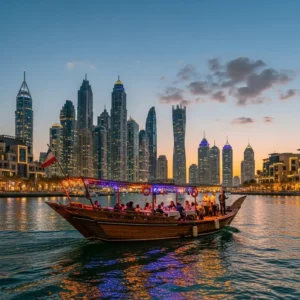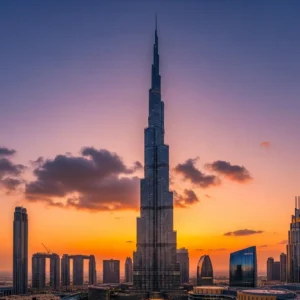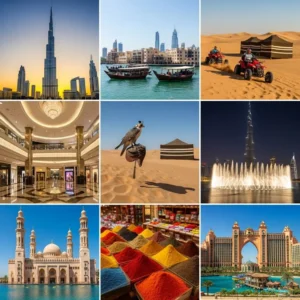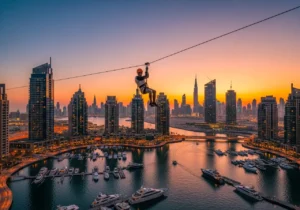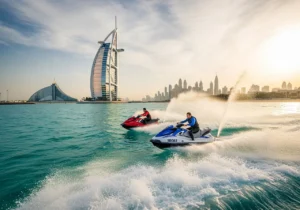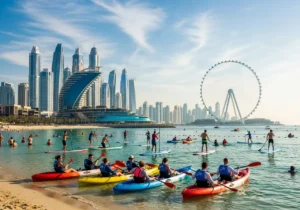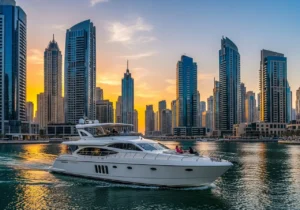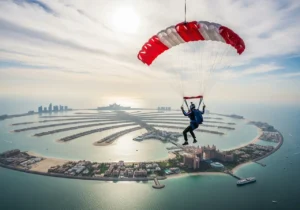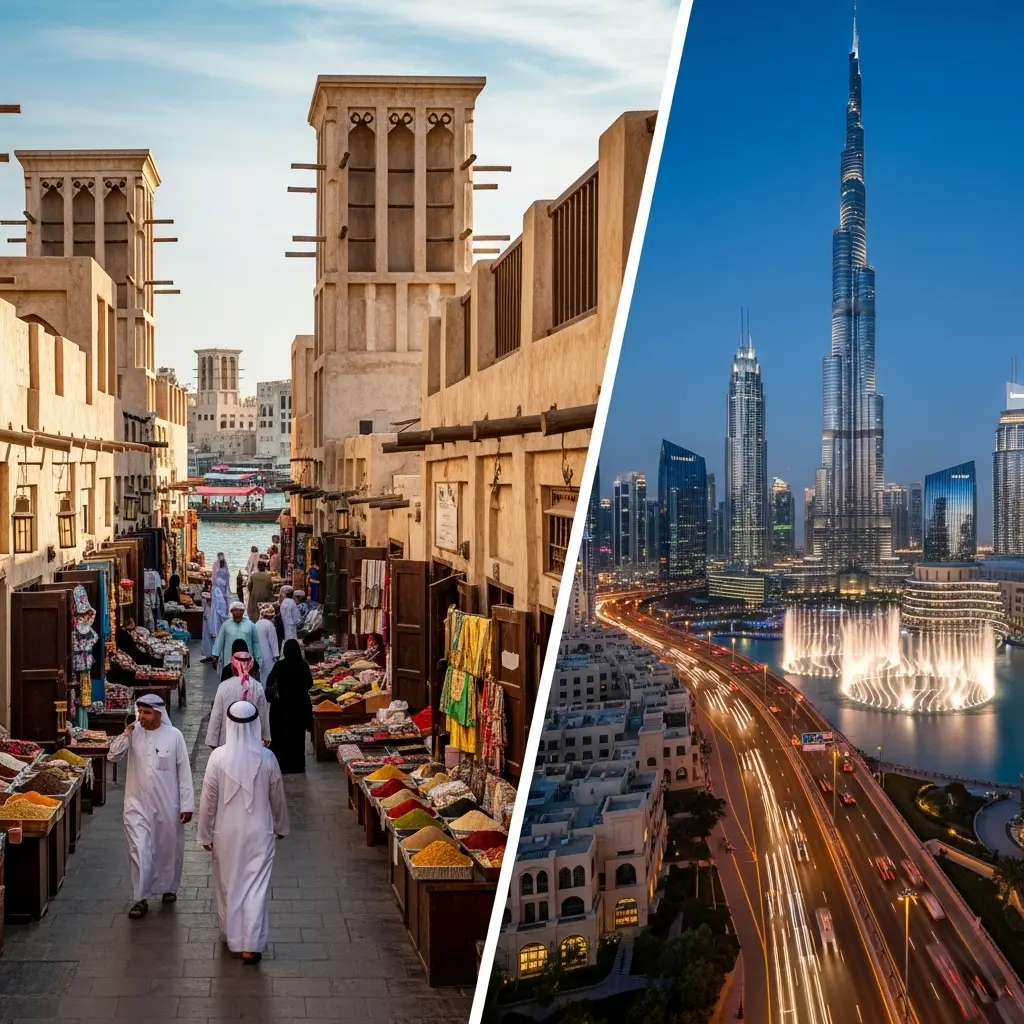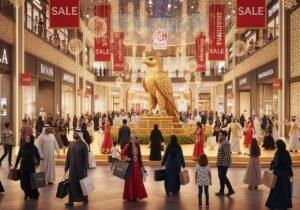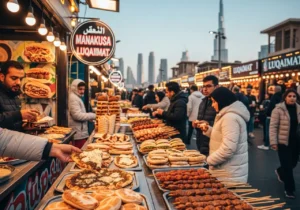Old Dubai vs. Modern Dubai: An Unforgettable Tale of Two Cities
The debate of Old Dubai vs Modern Dubai is at the heart of any trip to this mesmerizing emirate. It’s a choice between two worlds, coexisting yet distinctly different, offering unique narratives of a city that transformed from a humble pearling village into a global metropolis. One side whispers tales of ancient trade routes through its winding alleyways, while the other shouts ambition from the peaks of the world’s tallest skyscrapers. For any traveler, understanding this contrast is key to unlocking the true essence of Dubai.
This journey is not just about choosing a location; it’s about choosing an experience. Do you seek the sensory overload of a bustling spice souk, the gentle sway of a traditional abra on the creek, and the texture of history in the coral-stone walls? Or does your heart race for the glittering lights of a futuristic skyline, the thrill of unparalleled luxury, and the pulse of a city that constantly innovates? The beauty of the Old Dubai vs Modern Dubai dilemma is that there is no wrong answer, only a path that best suits your wanderlust.
This guide will navigate you through the soul of both Old and New Dubai. We will delve into the historical treasures of Al Fahidi, compare them with the architectural marvels of Downtown, and help you decide whether to lose yourself in the past or get swept up in the future. Or perhaps, you’ll discover that the most authentic Dubai adventure lies in embracing both.
The Soul of the City: Understanding the Charm of Old Dubai
To truly appreciate Dubai’s meteoric rise, one must first walk through its cradle. Old Dubai is the city’s historical and cultural anchor, a place where time slows down, allowing you to breathe in the atmosphere of a bygone era. It’s a vivid reminder of the city’s roots, long before the discovery of oil, when pearl diving and fishing were the lifelines of its people. The comparison of Old Dubai vs Modern Dubai always begins here, in these storied streets.
Here, the architecture tells a story. The low-rise buildings, constructed from traditional materials like gypsum, coral, and palm wood, stand in stark contrast to the glass and steel giants that dominate the modern skyline. The air is thick with the aroma of exotic spices, the sound of merchants haggling, and the call to prayer echoing from historic minarets. It’s an immersive experience that engages all your senses.
Exploring Old Dubai is like peeling back layers of history. Every corner reveals a new secret, from hidden courtyards to bustling marketplaces. This part of the city offers a glimpse into the authentic Emirati lifestyle, providing a much-needed context to the sprawling modernity that lies just a short distance away.
Al Fahidi Historical Neighbourhood (Al Bastakiya)
The Al Fahidi Historical Neighbourhood, also known as Al Bastakiya, is the sentimental heart of Old Dubai. Wandering through its labyrinthine alleys is a journey back to the 19th century. The area has been meticulously preserved, offering a tranquil escape from the city’s relentless pace. The iconic wind towers (Barjeel) punctuate the skyline, a testament to early Emirati ingenuity in natural air conditioning.
The buildings themselves are works of art, with ornate wooden doors and serene, shaded courtyards. This district is not a sterile museum piece; it’s a living, breathing cultural hub. You’ll find a delightful collection of art galleries showcasing local and international talent, quaint cafes offering traditional Arabic coffee (gahwa), and small museums that tell the story of Dubai’s heritage.
A visit to the Sheikh Mohammed Centre for Cultural Understanding (SMCCU) within Al Fahidi is a must for anyone invested in the Old Dubai vs Modern Dubai cultural debate. Here, under the motto “Open Doors, Open Minds,” you can participate in heritage tours and Q&A sessions to gain a deeper understanding of Emirati traditions and Islam.
The Bustling Waterway: A Journey on Dubai Creek
Dubai Creek is the city’s original lifeline. This natural saltwater inlet was the center of trade, connecting Dubai to the world and fostering the pearl diving and fishing industries that first brought it prosperity. Today, it remains a vibrant artery that beautifully separates the two main districts of Old Dubai: Bur Dubai and Deira. The Creek is where the essence of Old Dubai vs Modern Dubai is most palpable, as you can see the modern skyline from its historic waters.
The most authentic way to experience the Creek is by taking a ride on an Abra, a traditional wooden boat that has served as a water taxi for centuries. For just one dirham, you can cross the water alongside locals, enjoying unparalleled views of the old trading dhows, bustling promenades, and historic buildings lining the banks.
The journey offers a cinematic perspective of the city’s evolution. As the Abra glides across the water, the sounds of the city—the clang of cargo being loaded, the chatter of different languages, the distant hum of traffic—create a unique urban symphony. It’s a simple, inexpensive, yet profoundly memorable experience.
A Glimmer of Tradition: The Deira Souks
On the Deira side of the Creek lies a treasure trove of traditional markets, or souks. These markets are a chaotic, vibrant, and utterly captivating assault on the senses. They represent the commercial soul of Old Dubai and offer a shopping experience that is worlds away from the air-conditioned malls of the modern city. The souks are a critical point of comparison in the Old Dubai vs Modern Dubai shopping scene.
The Dazzling Gold Souk
The Deira Gold Souk is legendary. It’s a place where all that glitters truly is gold. Row upon row of shop windows are crammed with an astonishing amount of gold jewelry, from delicate chains to elaborate wedding necklaces, all sold by weight. Even if you have no intention of buying, walking through this covered market is an experience in itself. The sheer scale and craftsmanship on display are breathtaking.
The Aromatic Spice Souk
Just a short walk from the Gold Souk, the Spice Souk transports you to another world. The air is heavy with the fragrant aromas of cinnamon, cardamom, turmeric, saffron, and frankincense. Sacks overflowing with colorful spices, dried fruits, nuts, and fragrant teas line the narrow alleyways. Merchants are eager to share their knowledge, letting you smell and taste their wares. It is a photographer’s and a foodie’s paradise.
The Vibrant Textile Souk
Located on the Bur Dubai side of the Creek, the Textile Souk is a riot of color and texture. Here, you can find a vast array of fabrics, including fine silks, embroidered materials, and soft cottons. It’s the perfect place to buy pashminas, slippers, and traditional Arabic clothing, or to have an outfit custom-made by one of the many skilled tailors. Haggling is expected and part of the fun.
The City of the Future: Embracing the Splendor of Modern Dubai
If Old Dubai is the city’s soul, Modern Dubai is its audacious, glittering ambition. This is the Dubai that has captured the world’s imagination—a city of superlatives, where records are made to be broken and the impossible is made possible. It represents a bold vision for the future, characterized by groundbreaking architecture, unparalleled luxury, and world-class entertainment. The conversation around Old Dubai vs Modern Dubai often centers on these incredible feats of engineering.
Modern Dubai is a testament to what visionary leadership and relentless determination can achieve. It’s a sprawling metropolis of interconnected hubs, each with its own distinct personality, from the towering heights of Downtown to the glamorous waterfront of the Marina. This side of the city is defined by its scale, its opulence, and its constant pursuit of the next big thing.
Here, life is lived in the fast lane. It’s a world of Michelin-starred restaurants, exclusive beach clubs, mega-malls, and adrenaline-pumping activities. It’s a playground for the affluent and the adventurous, a city that is constantly reinventing itself to offer new and ever-more-spectacular experiences. For a different perspective, you can explore activities across the emirates with https://dubaidesertsafarie.com/.
Touching the Sky: The Marvels of Downtown Dubai
Downtown Dubai is the epicenter of modernity. It’s home to some of the city’s most iconic landmarks and is a bustling hub of activity day and night. This compact area packs a powerful punch, showcasing the pinnacle of modern urban living. Any discussion about Old Dubai vs Modern Dubai must feature this spectacular district.
The Unmissable Burj Khalifa
Dominating the skyline is the Burj Khalifa, the world’s tallest building. Standing at over 828 meters, this architectural marvel is a symbol of Dubai’s global stature. A trip to its observation decks, “At the Top,” on the 124th, 125th, and 148th floors, offers breathtaking 360-degree views of the city, desert, and ocean. Watching the sunset from this vantage point is a truly unforgettable experience.
The Colossal Dubai Mall
At the foot of the Burj Khalifa lies The Dubai Mall, one of the largest shopping malls in the world. But it’s far more than just a retail destination. It’s a complete entertainment complex, home to over 1,200 stores, hundreds of restaurants, a giant aquarium and underwater zoo, an Olympic-sized ice rink, and a massive cinema. You could easily spend an entire day here without getting bored.
The Mesmerizing Dubai Fountain
Set on the 30-acre Burj Khalifa Lake, The Dubai Fountain is the world’s largest choreographed fountain system. Every evening, the fountains come to life in a spectacular display of water, light, and music. Jets of water shoot up to 150 meters in the air, synchronized to a range of classical, Arabic, and world music. It’s a captivating show that draws huge crowds and provides a magical end to a day in Downtown.
The Man-Made Wonder: Dubai Marina and JBR
Dubai Marina is another jewel in the crown of Modern Dubai. It’s a stunning man-made canal city, carved along a stretch of the Arabian Gulf shoreline. The waterfront is framed by one of the most impressive skylines in the world, featuring a forest of skyscrapers, many of them with unique, twisted designs. The Marina is a vibrant residential and leisure hub.
Adjacent to the Marina is Jumeirah Beach Residence (JBR), a bustling beachfront promenade known as The Walk. This area is alive with energy, featuring a wide array of restaurants, cafes, boutiques, and street art. It’s the perfect place for a leisurely stroll, a delicious meal with a view, or simply to soak up the lively atmosphere. The beach at JBR is a popular spot for both tourists and residents, offering water sports and family-friendly activities.
An Icon of Luxury: Palm Jumeirah and Beyond
Palm Jumeirah is perhaps the most audacious of Dubai’s mega-projects. This artificial archipelago, shaped like a palm tree, is a world-renowned symbol of luxury and innovation. It’s home to some of the city’s most exclusive hotels, lavish villas, and high-end restaurants. The scale of the project is best appreciated from above, either from an airplane window, a helicopter tour, or while skydiving.
At the apex of the Palm stands the iconic Atlantis, The Palm resort. This sprawling complex is a destination in itself, featuring a world-class waterpark (Aquaventure), a massive aquarium (The Lost Chambers), and celebrity chef restaurants. The Palm also boasts a vibrant collection of chic beach clubs and a scenic boardwalk that is perfect for a sunset run or walk. This area truly highlights the luxury aspect in the Old Dubai vs Modern Dubai comparison.
Old Dubai vs Modern Dubai: A Head-to-Head Comparison
To help you better understand the distinct character of each side of the city, here is a direct comparison across several key aspects. This table breaks down the Old Dubai vs Modern Dubai experience.
Planning Your Itinerary: How to Experience Both Worlds
The ultimate Dubai trip doesn’t force you to choose between Old Dubai vs Modern Dubai; it encourages you to experience the best of both. The city’s excellent public transportation system makes it easy to travel between the two areas, allowing you to immerse yourself in history in the morning and touch the sky in the evening. For broader tour options, consider checking https://hafiztourism.com/.
A One-Day Whirlwind Tour
If you’re short on time, you can still get a taste of both sides of Dubai in a single day.
- Morning (9 AM – 1 PM): Start in Old Dubai. Take an Abra across the Creek, explore the Spice and Gold Souks in Deira, and then wander through the Al Fahidi Historical Neighbourhood.
- Afternoon (2 PM – 6 PM): Take the metro or a taxi to The Dubai Mall. Have lunch, and then visit the Dubai Aquarium or do some shopping.
- Evening (6 PM onwards): Ascend the Burj Khalifa for sunset views. Afterwards, have dinner at a restaurant overlooking The Dubai Fountain and watch the spectacular show.
A Deeper Dive: A Three-Day Itinerary
With more time, you can explore each area at a more relaxed pace.
- Day 1: The Heart of History. Dedicate the entire day to Old Dubai. Visit the Dubai Museum, explore all the souks, take a longer Abra ride, and have a traditional Emirati meal at a restaurant in Al Fahidi.
- Day 2: The Heights of Modernity. Focus on Downtown Dubai. Spend the morning at the Burj Khalifa and the afternoon exploring The Dubai Mall. In the evening, explore the trendy restaurants and lounges in the Business Bay area.
- Day 3: Sun, Sand, and Splendor. Experience Dubai’s glamorous coastline. Spend the morning at the beach at JBR, have lunch at Dubai Marina, and then explore Palm Jumeirah in the afternoon, perhaps visiting Atlantis. End the day with a sunset dinner cruise. Many desert adventures can also be booked via https://royaldesertadventures.ae/.
Tips for Seamless Travel Between Old and Modern Dubai
Getting between the two districts is surprisingly simple.
- Dubai Metro: The Red and Green lines of the Dubai Metro connect key areas of Modern and Old Dubai. It’s clean, efficient, and affordable. Key stations for Old Dubai include Al Fahidi and Al Ghubaiba (Green Line), while Burj Khalifa/Dubai Mall and DMCC (for the Marina) are on the Red Line.
- Taxis and Ride-Hailing: Taxis are plentiful and relatively inexpensive compared to other major cities. Services like Careem (a local favorite) and Uber are also widely available and offer a convenient way to travel point-to-point.
What to Pack for Your Dubai Adventure
Your packing list should reflect the dual nature of your trip, keeping in mind the need for both comfort and cultural respect. The constant of Old Dubai vs Modern Dubai travel is the strong sun.
- Respectful Attire: While Modern Dubai is quite liberal, it’s important to dress modestly when visiting Old Dubai and religious sites. Pack lightweight long pants or skirts and tops that cover the shoulders. A light scarf is versatile for women to cover their heads when entering mosques.
- Comfortable Footwear: You will be doing a lot of walking, especially in the sprawling souks of Old Dubai and the massive Dubai Mall. Comfortable shoes are non-negotiable.
- Sun Protection: The sun in Dubai is intense year-round. Pack high-SPF sunscreen, sunglasses, and a wide-brimmed hat.
- Reusable Water Bottle: Staying hydrated is crucial. Carry a reusable water bottle to refill throughout the day.
- Camera: From the historic details of Al Fahidi to the panoramic views from the Burj Khalifa, Dubai is incredibly photogenic.
The Verdict: Which Dubai is Right for You?
So, after exploring both sides, where does the Old Dubai vs Modern Dubai debate land? The truth is, the “right” Dubai depends entirely on your travel personality.
- Choose Old Dubai if: You are a history buff, a culture enthusiast, or a traveler on a budget. If you find joy in authentic experiences, sensory-rich environments, and discovering the story behind a place, the historical heart of the city will captivate you.
- Choose Modern Dubai if: You are a lover of luxury, an architecture aficionado, or a thrill-seeker. If you are drawn to glamorous skylines, world-class entertainment, and the energy of a city that is constantly looking forward, you will feel right at home amidst the skyscrapers.
Ultimately, the magic of Dubai lies in its duality. To only see the glittering towers of the Marina is to miss the soul of the city that resides by the Creek. To only wander the ancient souks is to ignore the incredible vision and ambition that built the modern marvel. The most enriching Dubai experience is one that carves out time for both, creating a journey filled with fascinating contrasts and a deeper appreciation for this extraordinary city.
Frequently Asked Questions (FAQs)
1. Is Old Dubai really worth visiting? Absolutely. Visiting Old Dubai is essential to understanding the city’s incredible transformation. It offers a rich cultural experience that provides context to the modern metropolis. The souks, the Dubai Creek, and the Al Fahidi Historical Neighbourhood are unique attractions that provide a glimpse into the authentic soul of the emirate, making the choice of Old Dubai vs Modern Dubai less of a choice and more of a combined itinerary.
2. How much time should I allocate to explore Old Dubai? You can see the main highlights of Old Dubai in half a day, but to truly soak in the atmosphere, a full day is recommended. This gives you ample time to explore the souks without rushing, visit the Dubai Museum, enjoy a leisurely Abra ride, and wander through the art galleries of Al Fahidi.
3. Is it easy to get from Modern Dubai to Old Dubai? Yes, it is very easy. The Dubai Metro is the most efficient way, with the Red Line connecting major hubs in Modern Dubai to transfer points for the Green Line, which serves Old Dubai. Taxis and ride-hailing services are also readily available and offer a convenient and direct route that typically takes 20-30 minutes depending on traffic.
4. What is the best way to get around Old Dubai? The best way to get around Old Dubai is on foot and by Abra. The main areas like the souks and Al Fahidi are pedestrian-friendly, and walking is the best way to discover hidden gems. For crossing the Dubai Creek between Bur Dubai and Deira, the traditional Abra boats are not only practical but also a memorable experience.
5. Can I use a credit card in the souks of Old Dubai? While many of the larger shops in the Gold Souk accept credit cards, most smaller vendors in the Spice and Textile Souks prefer cash (UAE Dirhams). It’s always a good idea to carry enough cash for smaller purchases, food, and Abra rides. Using cash can also give you better leverage when haggling.
6. Is haggling necessary in the souks? Haggling is expected and part of the cultural experience in the Spice and Textile Souks. It’s a friendly negotiation, not an argument. A good rule of thumb is to start by offering about half the asking price and meeting somewhere in the middle. In the Gold Souk, the price of gold is fixed by weight, but you can haggle on the “making charges” or the cost of the craftsmanship.
7. What are the main differences in dining between Old and Modern Dubai? The dining scene is a major point of contrast in the Old Dubai vs Modern Dubai experience. Old Dubai is famous for authentic, budget-friendly Emirati, Indian, and Pakistani cuisine, often found in small, family-run eateries and street food stalls. Modern Dubai is a global culinary destination, home to celebrity chef restaurants, fine dining establishments, and every international cuisine imaginable, often in luxurious settings with spectacular views.
8. Is Dubai safe for solo female travelers in both old and new areas? Dubai is widely regarded as one of the safest cities in the world for solo female travelers. This applies to both Old and Modern Dubai. Standard precautions should be taken, but the crime rate is very low. Dressing modestly, particularly in the more traditional areas of Old Dubai, is a sign of respect for the local culture.
9. What is the dress code for exploring Dubai? In Modern Dubai, especially in hotels, malls, and beach clubs, the dress code is quite relaxed, similar to any Western city. However, in Old Dubai and public places like the metro, it is advisable to dress more conservatively. This means covering your shoulders and knees. Women should carry a scarf, which is useful for entering mosques.
10. Can I find budget-friendly accommodation in Modern Dubai? While Modern Dubai is known for its luxury hotels, there are budget-friendly options available. Areas like Al Barsha and Tecom (Barsha Heights), which are well-connected by the metro, offer a range of affordable hotel apartments and 3-star hotels, providing a good balance between cost and access to modern attractions.
11. What is the best time of year to visit Dubai to enjoy both sides? The best time to visit is during the winter months, from November to March. The weather is pleasant and mild, perfect for walking around the outdoor areas of Old Dubai and enjoying the beaches and terraces of Modern Dubai. The summer months (June to August) are extremely hot and humid, which can make exploring outdoor attractions uncomfortable.
12. Are there cultural etiquette rules I should be aware of? Yes, being aware of local customs is important. Public displays of affection are frowned upon. During the holy month of Ramadan, eating, drinking, and smoking in public during fasting hours are prohibited. It’s also polite to accept Arabic coffee if offered and to use your right hand when eating or receiving items.
13. Which area is better for families with young children? Both areas offer attractions for families, but Modern Dubai is generally more geared towards them. It boasts numerous theme parks (like IMG Worlds of Adventure and Dubai Parks and Resorts), the Dubai Aquarium, KidZania in The Dubai Mall, and many family-friendly beaches and restaurants. Old Dubai can be fascinating for older children, but the crowds and heat might be challenging for very young ones.
14. If I only have one evening, what should I do? This is the classic Old Dubai vs Modern Dubai choice. For a modern, spectacular evening, head to Downtown Dubai to see the Burj Khalifa and the Dubai Fountain show. For a more cultural and atmospheric evening, take an Abra ride on the Creek at sunset, followed by dinner at a restaurant overlooking the water and a walk through the bustling souks.
15. Does the choice between Old and Modern Dubai affect my budget significantly? Yes, it can. Old Dubai is significantly more budget-friendly. You can eat delicious meals for a few dollars, cross the creek for pennies, and find affordable hotels in the Deira and Bur Dubai areas. Modern Dubai is where you’ll find the luxury hotels, fine dining, and expensive attractions, which can quickly add up. A balanced trip allows you to save in Old Dubai and splurge in the new parts.
